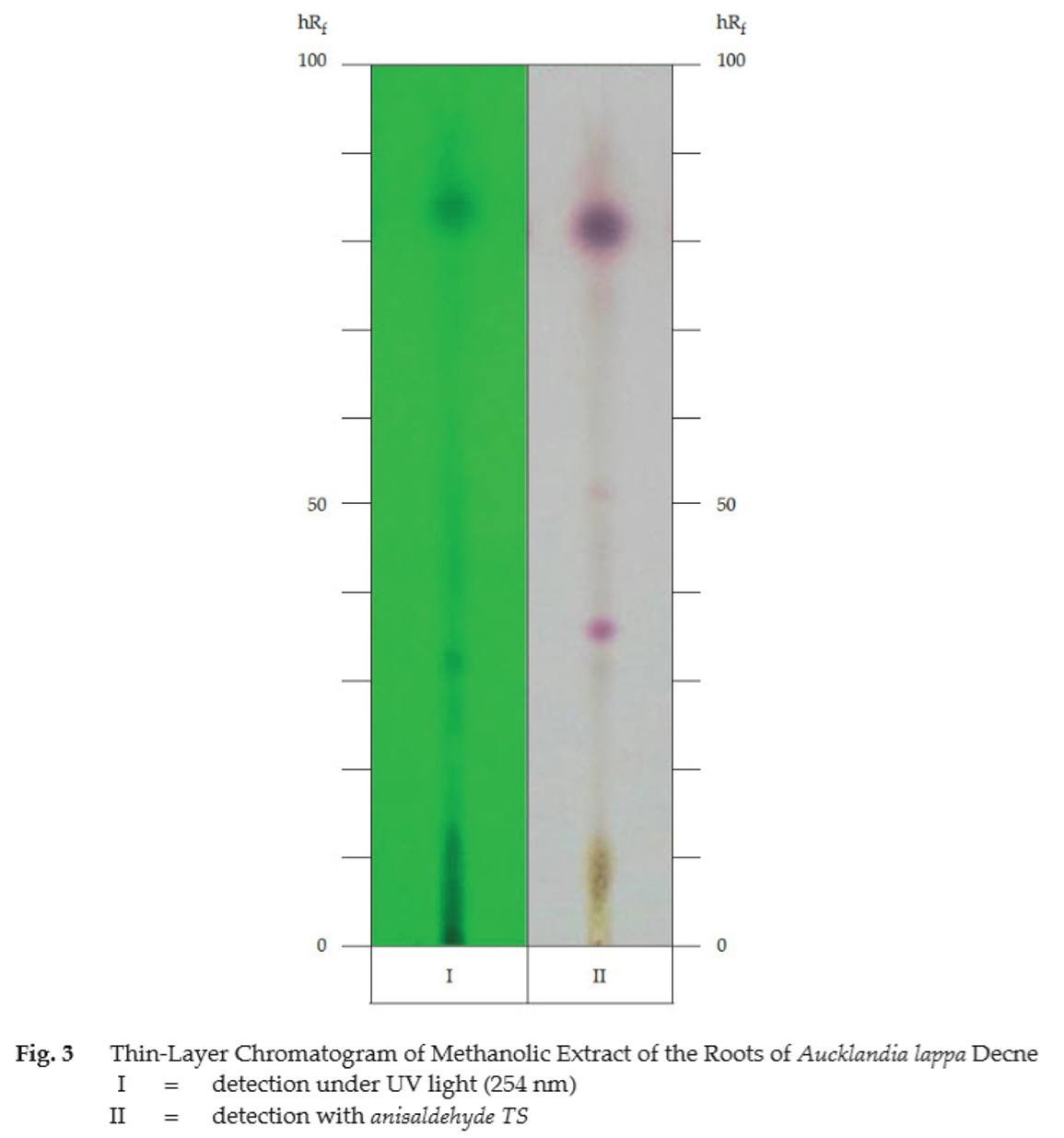ตำรามาตรฐานยาสมุนไพรไทย
Thai Herbal Pharmacopoeia
สำนักยาและวัตถุเสพติด กรมวิทยาศาสตร์การแพทย์ กระทรวงสาธารณสุข
Bureau of Drug and Narcotic, Department of Medical Sciences, Ministry of Public Health(Tinospora crispa (L.) Hook.f. & Thomson)
(Nelumbo nucifera Gaertn.)
(Centella asiatica (L.) Urb.)
(Centella Dry Extract)
(Centella Cream)
(Mesua ferrea L.)
(Piper sarmentosum Roxb.)
(Piper sarmentosum Roxb.)
(Pterocarpus santalinus L. f.)
(Santalum album L.)
(Senna tora (L.) Roxb.)
(Senna alata (L.) Roxb.)
(Senna Alata Tea)
(Piper retrofractum Vahl)
(Myristica fragrans Houtt)
(Andrographis paniculata (Burm. f.) Nees)
(Andrographis Capsules)
(Allium ascalonicum L.)
(Ocimum tenuiflorum L.)
(Curcuma longa L.)
(Turmeric Capsules)
(Turmeric Dry Extract)
(Turmeric Dry Extract Capsules)
(Arcangelisia flava (L.) Merr.)
(Curcuma sp.)
Harrisonia perforata (Blanco) Merr.
(Aristolochia pierrei Lecomte)
(Zingiber officinale Roscoe)
(Ginger Capsules)
(Ginger Tea)
(Cassia fistula L.)
(Nardostachys jatamansi (D. Don) DC.)
(Angelica sinensis (Oliv.) Diels)
Artemisia annua L.
(Ligusticum sinense Oliv. cv. Chuanxiong)
(Neopicrorhiza scrophulariiflora Pennell)
(Atractylodes lancea (Thunb.) DC.)
(Aucklandia lappa Decne)
(Terminalia chebula Retz.)
(Angelica dahurica (Hoffm.) Benth. & Hook. f. ex Franch. & Sav. var. dahurica)
(Kaempferia parviflora Wall. ex Baker)
(Hibiscus sabdariffa L.)
(Roselle Tea)
(Allium sativum L.)
(Zingiber zerumbet (L.) Sm.)
(Wurfbainia testacea (Ridl.) Škorničk.& A. D. Poulsen)
(Cannabis sativa L.)
(Myristica fragrans Houtt)
(Dracaena cochinchinensis (Lour.) S. C. Chen)
(Ficus racemosa L.)
(Hyptis suaveolens (L.) Poit.)
Clerodendrum indicum (L.) Kuntze
(Phyllanthus emblica L.)
(Citrus hystrix DC.)
(Citrus hystrix DC.)
(Areca catechu L.)
(Momordica charantia L.)
Moringa oleifera Lam.
(Aegle marmelos (L.) Corrêa)
(Solanum trilobatum L.)
(Morus alba L.)
Gynostemma pentaphyllum(Thunb.)
Makino
(Clinacanthus nutans (Burm. f.) Lindau)
(Cissus quadrangularis L.)
(Mimusops elengi L.)
(Zingiber montanum (J. König) Link. ex A. Dietr.)
(Piper betle L.)
(Capsicum annuum L.)
(Capsicum Oleoresin)
(Capsicum Gel)
(Piper nigrum L.)
(Piper nigrum L.)
(Eurycoma longifolia Jack)
(Thunbergia laurifolia Lindl.)
(Piper wallichii (Miq.) Hand.-Mazz.)
Senna garrettiana (Craib) H. S. Irwin & Barneby
(Terminalia bellirica (Gaertn.) Roxb.)
(Terminalia chebula Retz.)
(Caesalpinia bonduc (L.) H. Roxb.)
(Tarlmounia elliptica (DC.) H. Rob., S. C. Keeley, Skvaria & R. Chan)
(Hog Creeper Vine Dry Extract Capsiles)
(Hog Creeper Vine Dry Extract)
(Brachypterum scandens (Roxb.) Miq.)
(Lepidium sativum L.)
(Nigella sativa L.)
(Cuminum cyminum L.)
(Foeniculum vulgare Mill.)
(Plantago ovata Forssk.)
(Pimpinella anisum L.)
(Carum carvi L.)
(Anethum graveolens L.)
(Trachyspermum ammi (L.) Sprague)
Albizia procera (Roxb.) Benth.
(Acorus calamus L.)
(Tiliacora triandra (Colebr.) Diels)
Cyanthillium cinereum (L.) H. Rob.
(Orthosiphon aristatus (Blume) Miq.)
Murdannia loriformis (Hassk.) R. S. Rao & Kammathy
(Capparis micracantha DC.)
(Chrysopogon zizanioides (L.) Roberty)
(Cyperus rotundus L.)
(Cannabis sativa L.)
(Syzygium aromaticum (L.) Merr. & L. M. Perry)
(Boesenbergia rotunda (L.) Mansf.)
(Acanthus ebracteatus Vahl)
(Acanthus ilicifolius L.)
(Kaempferia galanga L.)
(Curcuma comosa Roxb.)
Betula alnoides Buch.-Ham. ex D. Don
Cannabis sativa L.
Carthamus tinctorius L
Mitragyna speciosa (Korth.) Havil
Mallotus repandus (Rottler) Müll. Arg
Azadirachta indica A. Juss. var. siamensis Valeton
Azadirachta indica A. Juss. var. siamensis Valeton
Punica granatum L.
Rhinacanthus nasutus (L.) Kurz
Baliospermum solanifolium (Burm.) Suresh
Curcuma aeruginosa Roxb
Boesenbergia kingii Mood & L. M. Prince
Senegalia rugata (Lam.) Britton & Rose
Acacia concinna (Willd.) DC.
Senegalia rugata (Lam.) Britton & Rose
Acacia concinna (Willd.) DC.
Senna alexandriana Mill. var. alexandriana
Cassia acutifolia Delile, Cassia angustifolia Vahl
Butea superba Roxb. ex Willd.
[Plaso superba (Roxb. ex Willd.) Kuntze, Rudolphia superba (Roxb. ex Willd.) Poir.
Pueraria candollei Graham
ex Benth. var. mirifica (Airy Shaw & Suvat.) Niyomdham
Streblus asper Lour.
Suregada multiflora (A. Juss.) Baill. (Gelonium
multiflorum A. Juss.
Common Aucklandia Root is the dried root of Aucklandia lappa Decne (Family Compositae), Herbarium Specimen Number: see Additional information 1, Crude Drug Number: DMSc 0938.
Constituents Common Aucklandia Root contains volatile oil, of which dehydrocostus lactone and costunolide are its major components. It also contains alkaloids (e.g., saussurine), cyanopicrin, etc.
Description of the plant (Figs. 1a, 1b) Perennial herb, 1 to 2 m tall; stem erect, robust; root tuberous, large, brown, triangular, about 60 cm long, about 5 cm in diameter, with longitudinal ridges, woody, with peculiar smell. Leaves simple, opposite, triangular or cordate, 0.6 to 1.2 m long, about 30 cm wide, upper leaves 20 to 30 cm long, 17 to 30 cm wide, apex acute or obtuse, base auriculate, margin irregularly toothed, membranous; petiole long, lobately winged, clasping stem. Inflorescence in axillary and terminal corymb, 2.5 to 3.5 cm wide. Capitulum bluish purple, about 2 cm long, 2.5 to 3.8 cm in diameter; involucre globose to campanulate or tubular; phyllaries many-seriate, imbricate, ovate-lanceolate, with scarious apical recurved appendage; receptacle glabrous or setose. Floret usually rose-purple, sometimes white, bisexual, fertile; corolla about 2 cm long, tubular, apex 5-lobed, dark blue-purple or almost black; stamens 5, free, filament glabrous, anther sagittate, with fringed appendage; ovary inferior, 1-loculed, ovule 1, style 2-armed. Fruit achene, up to 8 mm long, curved with narrow tip, compressed, obsoletely 4-angled, hairy; pappus 2-seriate, bristle, about 1.7 cm long, connate at base, persistent, outer short, scabrous to plumose, deciduous, inner plumose.
Description Odour, aromatic and characteristic; taste, slightly bitter.
Macroscopical (Fig. 1a) Cylindrical, 8 to 12 cm long, 1 to 5 cm in diameter. Externally yellowish brown to greyish brown, with distinct wrinkles, longitudinal furrow and lateral root scars. Texture hard, uneasily broken, fracture greyish brown to dark brown.
Microscopical (Figs. 2a, 2b, 2c) Transverse section of the root shows periderm, cortex, phloem, xylem, lysigenous intercellular spaces, and cracked spaces. Periderm, 3 to 12 layers of varying sizes of rectangular cork cells. Cortex, narrow region of thin-walled parenchyma cells and sclereids. Phloem tissue, thin-walled parenchyma, some of which containing oleoresin, 4 to 5 rows of phloem rays and lysigenous intercellular spaces. Xylem tissue, 1 to 2 rows of vessels, 2 to 5 rows of xylem rays and lysigenous intercellular spaces. Cracked space, found in the joint area of phloem tissue and xylem tissue.
Common Aucklandia Root in powder possesses the diagnostic microscopical characters of the unground drug. Elongated, thick-walled sclereids are characteristic features. Thin-walled cork cells and inulin masses are frequently observed. Parenchyma with oleoresin or with inulin masses may also be seen.

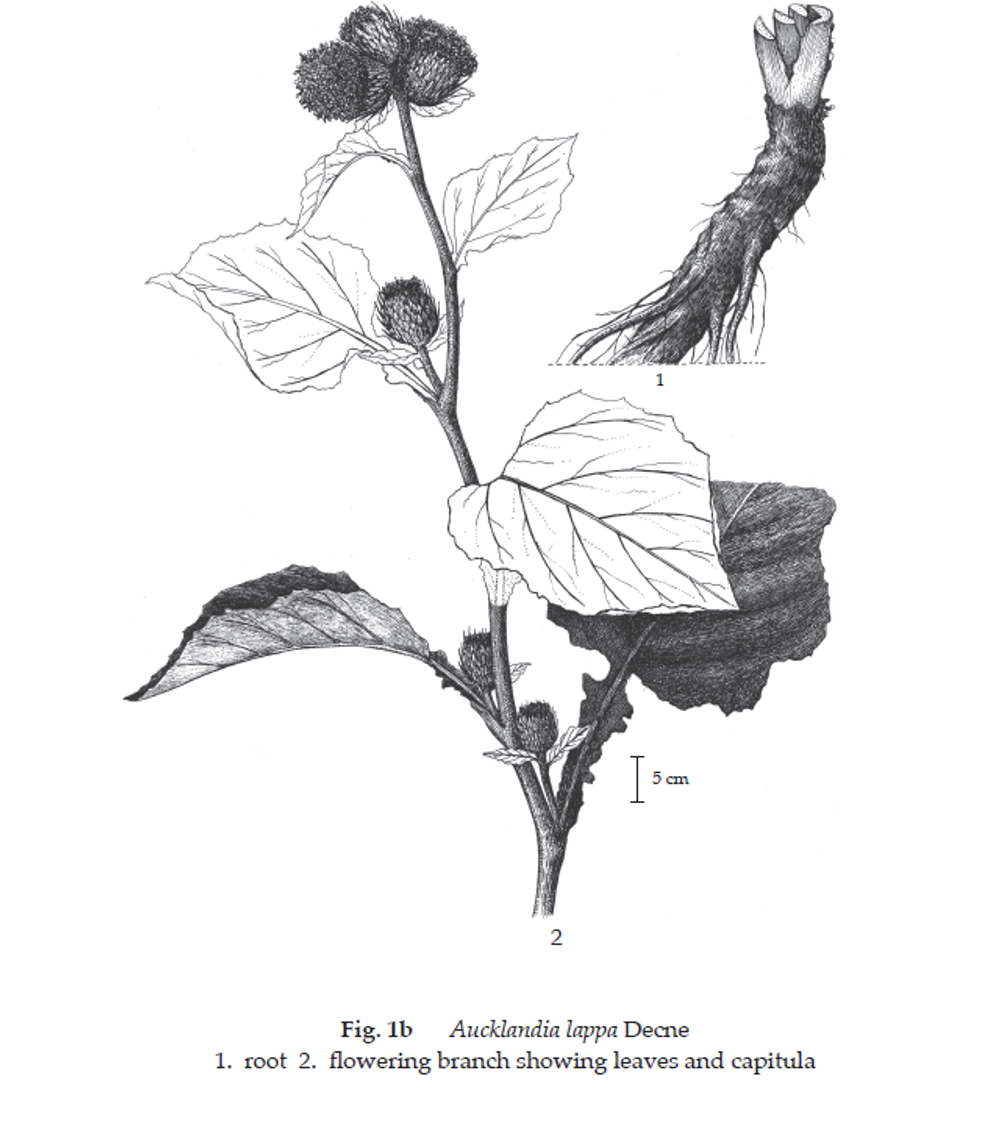
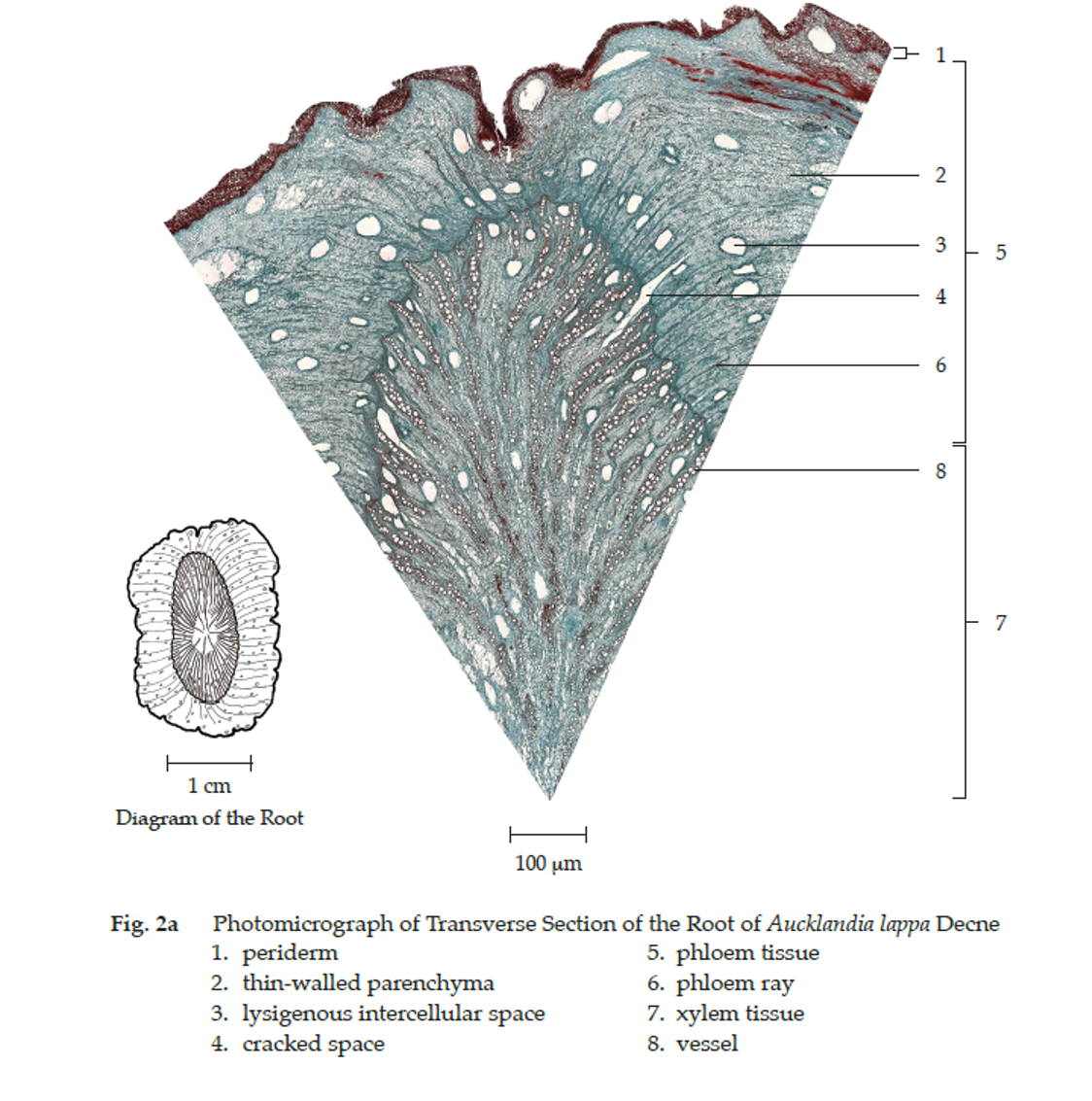
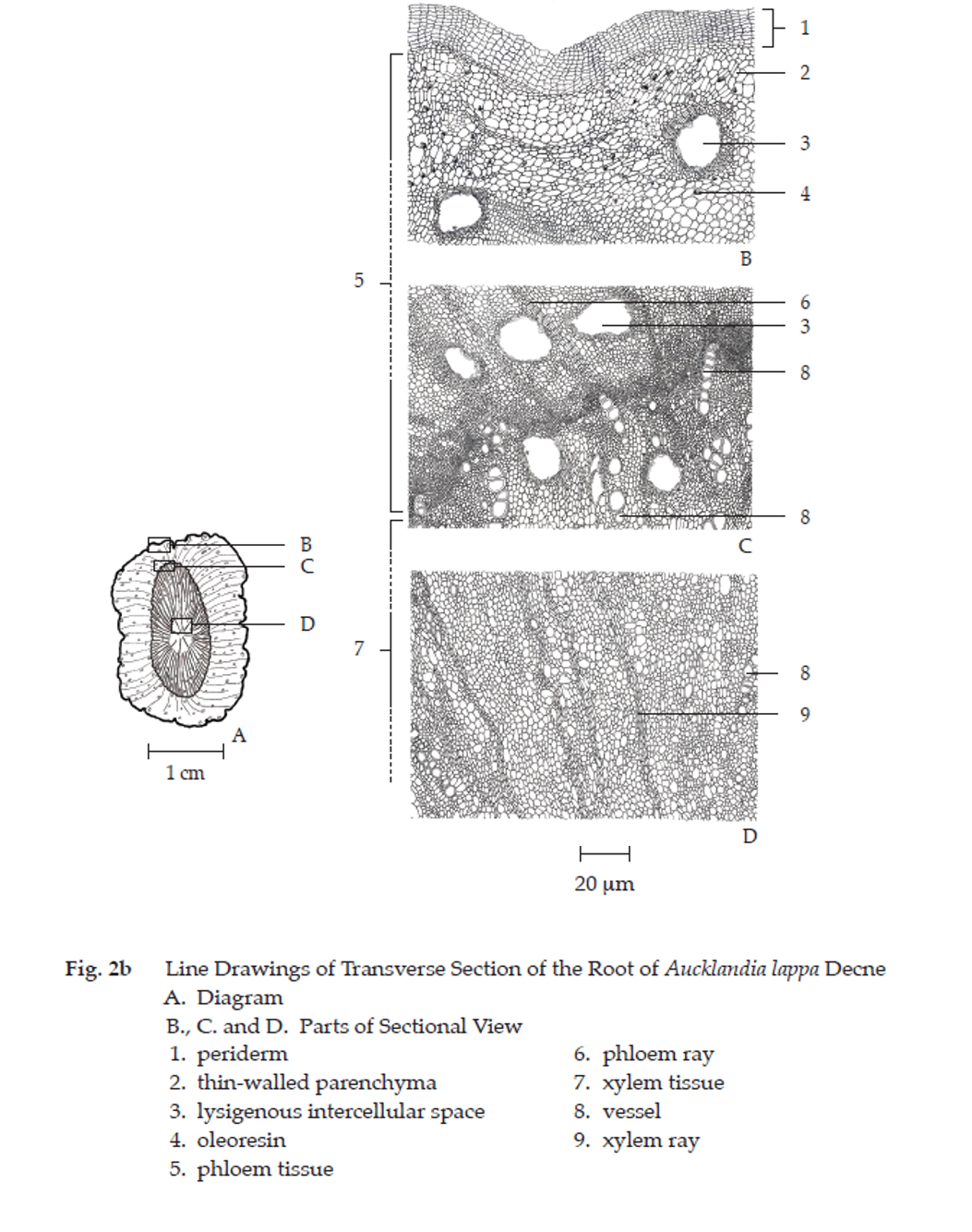
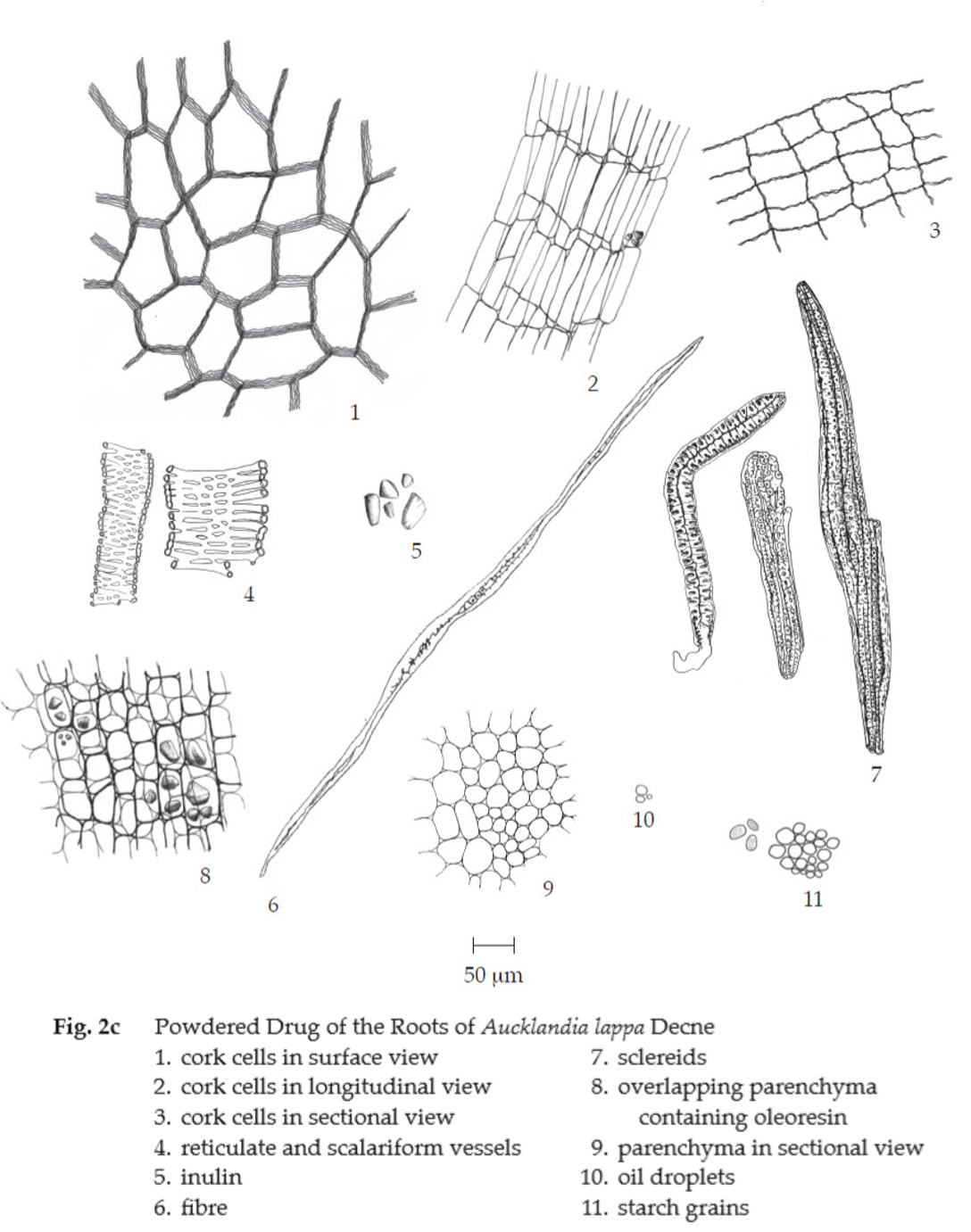
Additional information
1. Common aucklandia plant is not native to nor commercially cultivated in Thailand. The plant yielding common aucklandia root is here referred to the herbarium specimen number K000372736, deposited at the Herbarium, Royal Botanic Gardens Kew (K), London, United Kingdom. The photographic illustration of the specimen can be seen at the Department of Medical Sciences Herbarium (DMSC), Nonthaburi, Thailand.
2. It is commonly used with other herbal drugs in Thai traditional herbal preparations.
Packaging and storage Common Aucklandia Root shall be kept in well-closed containers, protected from light and moisture, and stored in a cool and dry place.
Identification
A. Reflux 1 g of the sample, in powder, with 10 mL of ethanol (80 per cent) for 30 minutes, allow to cool and filter. Evaporate the filtrate to dryness, dissolve the residue in 5 mL of a 5 per cent w/v solution of hydrochloric acid and filter. To 1 mL of the filtrate, add a few drops of modified Dragendorff TS: an orange precipitate is produced.
B. Shake 2 g of the sample, in powder, with 10 mL of chloroform for 15 minutes and filter. To 2 mL of the filtrate, slowly add 1 mL of sulfuric acid to make two layers: a reddish purple ring is produced at the zone of contact.
C. Carry out the test as described in the “Thin-Layer Chromatography” (Appendix 3.1), using silica gel GF254 as the coating substance and a mixture of 60 volumes of dichloromethane, 20 volumes of ethyl acetate, 20 volumes of methanol, and 2 volume of strong ammonia solution as the mobile phase and allowing the solvent front to ascend 10 cm above the line of application. Apply to the plate, 5 μL of the test solution prepared by refluxing 1 g of the sample, in powder, with 25 mL of methanol for 30 minutes, filtering and evaporating the filtrate to dryness. Dissolve the residue in 1 mL of methanol. After removal of the plate, allow it to dry in air and examine under ultraviolet light (254 nm), marking the quenching spots. Spray the plate with anisaldehyde TS and heat at 110° for 10 minutes; two brown and two purple spots are observed (Table 1); see also Fig. 3.
Table 1 hRf Values of Components in Methanolic Extract of the Roots of Aucklandia lappa Decne
| Spot | hRf Value | Detection | |
| UV 254 | Anisaldehyde TS | ||
| 1 2 3 4 5 |
5-13 32-34 34-37 50-52 75-83 |
quenching quenching - - quenching |
brown - purple pale brown purple |
Water Not more than 11.0 per cent v/w (Azeotropic Distillation Method, Appendix 4.12).
Foreign matter Not more than 2.0 per cent w/w (Appendix 7.2).
Acid-insoluble ash Not more than 1.0 per cent w/w (Appendix 7.6).
Total ash Not more than 6.0 per cent w/w (Appendix 7.7).
Ethanol-soluble extractive Not less than 11.0 per cent w/w (Appendix 7.12).
Water-soluble extractive Not less than 27.0 per cent w/w (Appendix 7.12).
Volatile oil Not less than 0.7 per cent v/w (Appendix 7.3H). Use 20 g, in coarse powder, freshly prepared and accurately weighed. Use 200 mL of water as the distillation liquid and a 500-mL round-bottomed flask. Distil at a rate of 2 to 3 mL per minute for 5 hours. Use 2.0 mL of xylene in the graduated tube.
Dose 200 mg to 1 g of the powdered drug a day.
